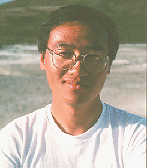 João Lin Yun
João Lin Yun  João Lin Yun
João Lin Yun To obtain this document in Portuguese please click here.
As a member of the Center for Astronomy & Astrophysics, and researcher of the Observatório Astronómico de Lisboa, and as staff Professor at the Physics Department of the Faculdade de Ciências of the University of Lisbon, I teach courses of the Physics BS degree and of the Master's degree in Astronomy and Astrophysics.
I can be reached at my office's address:
Observatório Astronómico de Lisboa
Tapada da Ajuda
1349-018 Lisboa, PORTUGAL
Telefone: 21 361 6739
FAX: 21 361 6752
or through E-mail: Joao.Yun "at" oal.ul.pt
The line of research that I have been exploring with BSc., MSc., and PhD. students, is focused on the study of the physical conditions and stellar content of molecular clouds. We use techniques of optical, infrared and radio astronomy in the following lines of research:
Similarly, objects in later stages of evolution, closer to the main-sequence, are optically visible. Spectra of these objects allow us to confirm their T Tauri star character. CCD images of these regions were used to search for the presence of HH objects and optical jets in the vicinity of the young stars.